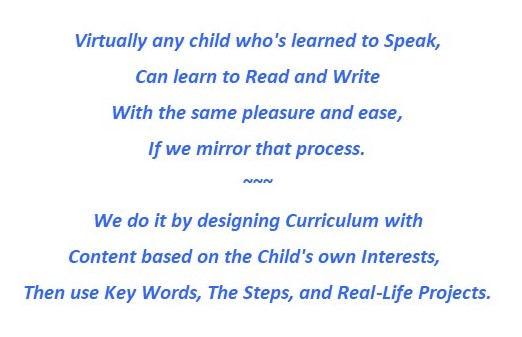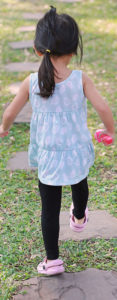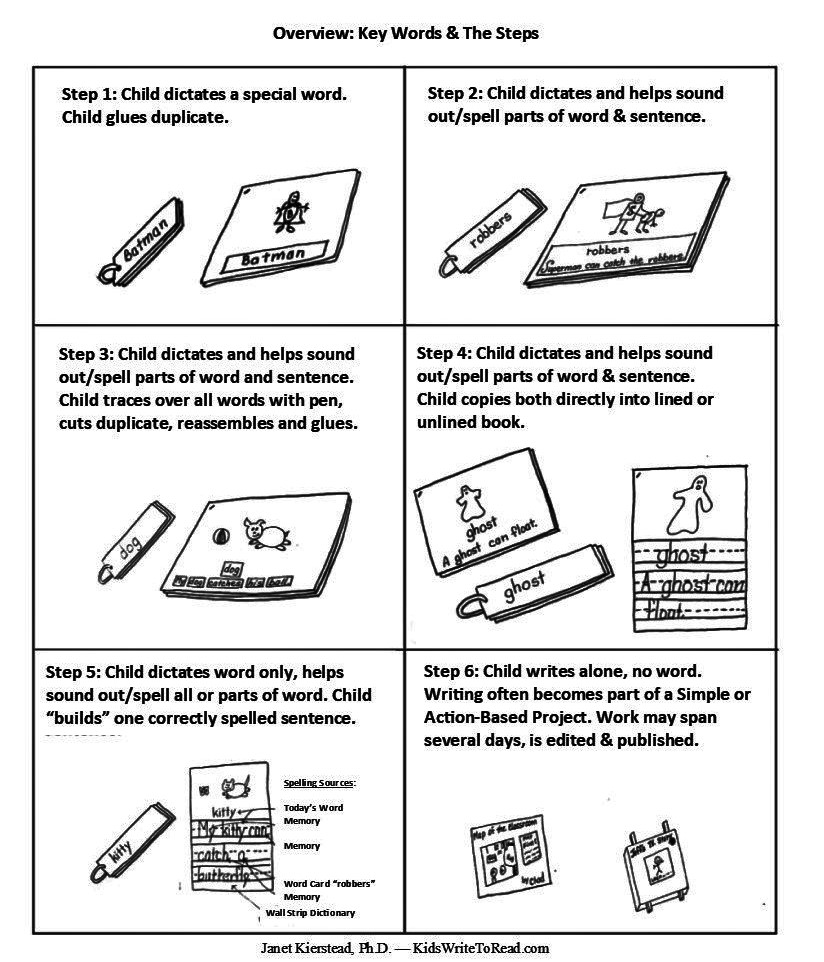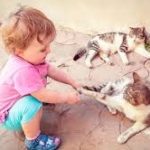
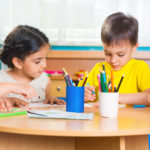

The child’s natural process
Nature equips the child with the ability to accomplish amazing things in their early years. They learn to walk, talk, and otherwise navigate a very complex environment.
We don’t directly “teach” them how to accomplish all this. They seem to have their own build-in way of doing it.
But we do need to intervene more directly with reading and writing. So to figure out how to best do that, we look now at how they accomplished so much in their early years.
As we begin, it’s immediately obvious that —
A child comes into the world already equipped with both the strong desire and ability to copy what they see us doing.
Exactly how a child does this remains hidden to us.
But we can certainly see the outward effects of their process as it unfolds. And looking carefully at it, we can draw some conclusions about how to help them later.
So that’s where we begin here, with a child learning to talk.
Learning to Talk
Now recall how a child learns to talk. Again we don’t directly “teach” them. That is, we don’t sit them in their high chair and demonstrate how to say the words we have decided they should focus on that day.
We don’t break the words down into separate sounds, then describe how the child should place their tongue just so and use their breath in certain ways to make those sounds.
Instead, while we are carrying out some “real life” activity with special meaning for the child, we model the words associated with it.
 For instance, if a cat comes into the room, we may pet it, saying things like, “Hello Kitty!.. Let’s pet the kitty… Be gentle with the kitty… Good Kitty…” and so on.
For instance, if a cat comes into the room, we may pet it, saying things like, “Hello Kitty!.. Let’s pet the kitty… Be gentle with the kitty… Good Kitty…” and so on.
After a few times of this, the child will excitedly call out “Keee, keee!” when the cat appears. Eventually one day, we hear them clearly say, “Kitty!”
In response, we probably smile and say something like, “Yes, here comes the kitty!”
Exactly how the child accomplishes this — and so much else — remains a mystery to us. And we don’t need to know.
What we do need to know and to trust is that — barring some extreme physical barrier — they can and will continue to develop the ability to speak as we model for them in this way.
So for our purposes here, we can note that we don’t “teach” a child to talk, in the direct, traditional sense, but —
We help a child learn to speak by using words with strong meaning for that child — while in a “real life” situation.
Scribbling: A significant Clue
Once the child can speak fluently, our challenge is to decide what comes next. That is, what’s the best way — the safest way — to help them move from speech into print?
Here we can look at how a child who’s been immersed in a print-rich environment in their early years respond. Having been read to often and watched others write, what do they do, if left to their own devices?
And in a print-rich environment, they will also, no doubt, have access to something akin to pencil and paper. So in an attempt to copy some of what they’ve seen others doing, they will start Scribbling and Drawing.
One day they make indiscernible marks on their paper, look up proudly and say something like, “See, this is our kitty, and here’s where it says ‘Kitty.’”
With this they are showing us they now realize print is used to convey ideas/speech —and they want to do it themselves.
Scribbling is one of the most valuable clues the child gives us. For this tells us that —
As the child grows, they continue to strive to communicate what’s at their center. So once they can speak, the next challenge they want to take on is translating that speech into print.1
If we combine this with the realization that they most readily copy what has strong meaning for them, we can devise practical strategies for an approach that’s “natural” for the child.
Doing that over the years, I have found that a child will progress through 5 increasingly complex stages toward reading books.
So let’s look next at the child’s natural path.
5 Stages in A child’s natural Path toward reading
From birth forward, the child is intent on communicating what’s at their center.
As an infant, they convey their feelings through Crying and various forms of Body Language. Before long, they begin to develop Speech.
Virtually all children make it this far.
If in a print-rich environment, they will begin to Scribble. And it’s here that we need to intervene, to model how to translate their own speech into print.
With this modeling, a child continues, ultimately working through the following 5 stages:
1. Crying/Body language –>
2. Speech –>
3. Scribbling/Drawing –>
4. Writing —>
5. Reading Books
The child proceeds along this path propelled by their desire to communicate what’s on their mind. So the last stage for the child is Reading Books2 written by someone else.
This, as such books represent what’s on someone else’s mind — or perhaps what an author thinks might be on a child’s mind.
It’s important to note that distinction: The child’s easy, natural path toward reading ends with reading books others have written. It doesn’t begin there.
Is this the case with all children?
I can hear someone saying — but I know a preschool child who learned to read at home — all on their own. So doesn’t that negate this claim that children need to move from speech to writing before reading?
I’m saying it’s far easier to follow that path, and that if we look at what the child is trying to do from birth forward, we can see that it’s their natural path.
My answer to that is — no, for it’s the unusual child who manages to do that. And I’m not claiming it cannot be done. Those in a print-rich environment may make the leap from speech to book reading.
How they did it will be virtually impossible for us to figure out — just as we don’t know exactly what a child does as they learn to speak. And just as we don’t know how Mozart was able to write his first symphony at the age of eight.)
So unless you have another Mozart on your hands, it’s best to take them on what appears to be their natural path.
What I’m saying is that it’s far easier for virtually any child to move from speech through writing and into translating someone else’s print back into speech. So who knows what might have happened if that early reader was shown how to write before they figured out reading.
What I’m saying is that most children will find it much easier to learn to read with pleasure and ease if we help them build a bridge between their own speech and translating the speech of others, in books. Further, those who do make the leap are still left needing to learn to write.
Bottom line is I’m way more interested in helping those who haven’t made that leap on their own. For I’ve witnessed too many children who are asked to make the leap from speech to books and struggle to do it — even completely fail.
What if a child is required to skip writing?
For most children deciding to move them from Speech directly into Reading Books, interrupts their easy, natural process, making any child’s progress more difficult. So let’s consider how that looks for children from different home experiences:
A. Child from a print-rich environment: These children have probably already reached the Scribbling/Drawing stage. But most have not yet moved into Writing — so here’s how the challenge looks for them if they are asked to begin by reading books:
1.Crying/body language –> 2.Speech –> 3.Scribbling/Drawing –> 4.Writing —> 5. Reading Books
When faced with a reading program that skips writing — one which begins with basal readers or by focusing on phonics, then phonics books — some children from a print-rich environment may struggle a bit, perhaps a great deal. Yet it’s likely they will ultimately bridge the gap.
B. Child NOT from a print-rich environment: These children have stopped at Speech. So by skipping writing, the challenge for them looks something like this:
1.Crying/body language –> 2.Speech –> 3.Scribbling/Drawing –> 4.Writing —> 5. Reading Books
Too many of these children struggle, even completely fail to make it across the divide. This affects them in school and far beyond. And it is completely unnecessary.
A child who has not yet gone beyond Speech need not be at such a strong disadvantage. For if we show them how their own words look in print, they quickly come to realize print is “talk written down” and move steadily forward.
All children can be successful, as long as they all have similar modeling from us. Some will just need a little more time.. So —
Each child needs to progress at their own pace. And that’s why we provide an individualized, natural approach.
Following is a brief description of the practical strategies within this approach.
Key Words: at the heart of an Individualized, natural approach
Keeping in mind how important hearing words with strong meaning was for the child learning to speak, we now use a similar strategy. That is, we model how their own speech must be written, if others are to readily understand it.
We do this by writing for them one special word each day — a word they ask for after telling us why it’s so important to them. This is their “Key Word” for the day.
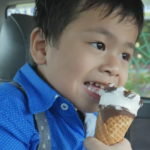 So for instance, they are telling us how much they like ice cream. They talk about the last time they had an ice cream cone, how it dripped down on their hand holding the cone, what flavor
So for instance, they are telling us how much they like ice cream. They talk about the last time they had an ice cream cone, how it dripped down on their hand holding the cone, what flavor  they especially like, etc. Eventually we write “ice cream” on a sturdy “word card” for them. They punch a hole in the card and place it on their metal “word ring.”
they especially like, etc. Eventually we write “ice cream” on a sturdy “word card” for them. They punch a hole in the card and place it on their metal “word ring.”
This is today’s Key Word for that child.
We also give them a duplicate of the word card — this one on newsprint. Their follow-up activity is to draw a picture about that day’s word in their writing book and paste the duplicate under their drawing.
Virtually always, they will recognize this word the next day, because it has special meaning for them. Also, they focused on it for quite awhile that previous day, so it “sticks.”
Forgetting yesterday’s word very seldom happens. But in that rare case, we take the word off the ring and talk a little longer to be sure they’re thinking of something with strong meaning for them.
We’re especially careful about this. For we want them to have a collection of words that gives them not only practice, but confidence with print.
Note that at this point, they are remembering/recognizing words, more than what we usually think of as reading. But reading, in the traditional sense, is not far away.
For as you will soon see, we will provide a structure to ensure their progress toward that goal.
Incorporating phonics, letter formation and more into Key Words
As we write their special word day after day — we also say the letters and/or make the sounds as we write. We do this incidentally, not in a way that interrupts the writing process. With this, just as they did with speech, the child begins to absorb the connections.
So in this way, we incorporate phonics into this process from the very beginning. And we expand on it with their need to spell, once they are writing independently.
They also trace over the letters in the key word we print for them during each session. So they begin to learn how to form letters, use simple punctuation, and see when capital letters are needed.
Before long, they will have absorbed enough information and honed enough motor skill to move comfortably into the next stage: Writing.
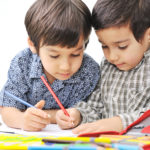 By the time they can write independently, they have been reading back their own work, as well as noticing the same words appearing in the writing of others. They have a sound foundation in phonics, know how to spell the common “connecting” words and some of the other words that just need to be memorized.
By the time they can write independently, they have been reading back their own work, as well as noticing the same words appearing in the writing of others. They have a sound foundation in phonics, know how to spell the common “connecting” words and some of the other words that just need to be memorized.
From this, they have gained virtually all the skills that go into reading, so that they can move comfortably into Reading (professionally published) Books.4
To the casual observer, it’s as if reading has spontaneously emerged from the writing process. And some children will actually think they “just happened” to learn to read.
But the ability to read books others have written did not “just happen.” We very carefully orchestrated it through a structure we refer to as The Steps.5
The Steps: a Structure to ensure success with writing, then reading
As the child progresses at their own pace, the follow-up activity they do with their Key Word changes. To guide their skill development, the child works their way through a series of increasingly complex follow-up activities, referred to as The Steps.
The Steps emerged as I responded to the growth of the children in my own K-2 classroom.
As a child moves forward through these Steps, it’s important their process be challenging enough to be novel and interesting, but not too difficult. So built into The Steps is a set of criteria, provided at the bottom of this page. The adult guiding them uses these criteria to decide when a child is ready to move forward. So —
The Steps, along with Key Words, allow the child to progress at their own pace through an individualized, fail-safe, child-friendly process.
Here’s what a child is doing at each of The Steps:
Another benefit to taking a path through writing
Not only does moving through writing make the process easier for the child. But also notice that it broadens the final outcome. For —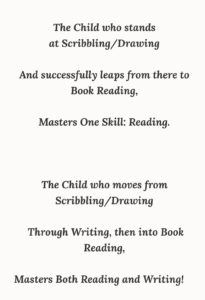
__________
1. Montessori also found children began to write, before reading — at around 4 years old.
2. The term “Reading Books” refers to the “cold” reading of professionally published books. But in fact, the child as been “reading” long before this. First, we have been reading nursery rhymes and children’s books to them early and often — with them sitting beside us, perhaps repeating some of what we read, singing with us, and helping us turn the pages. But on their own, they have also learned to read people’s expressions, body language and intonation. They have been reading/recognizing labels and the writing on their cereal box, and so forth. Read more about the complexity of reading.
3. For more about this decision, see the subheading, First Consider: Are We Teaching Reading Or Are We Helping the Child Learn To Read? on the page, Key Words & The Steps.
4. Read how once a child is writing their own thoughts, we move them into professionally published books.
5. This is my adaptation of Key Vocabulary, developed by Sylvia Ashton-Warner. A detailed practical description on the page Key Words & The Steps. “The Steps” are follow-up activities I devised for Key Words. The website, KidsWriteToRead.com also includes more about phonics, classroom management, some math, and virtually all other aspects of a natural approach.
Here’s another way to envision the child’s natural path:
next —> Snapshot of a natural approach to learning
< — back What About Curriculum?
Questions/Comments: KidsWriteToRead@yahoo.com
